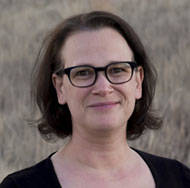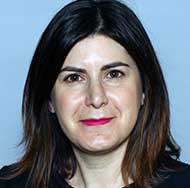In this issue, we talk with two members of the multi-organizational CARES Committee about their efforts to support the radiology profession as the use of patient shielding in radiology evolves. Rebecca Milman, PhD, Medical Physicist at the University of Colorado School of Medicine, and Darcy J. Wolfman, MD, Diagnostic Radiologist at Johns Hopkins Medicine, share their journey to develop clear, consistent communication about patient shielding that will improve patient care.
Tell us a little about the CARES Committee — why it was formed, who is involved and what role it plays in enhancing quality and safety in radiology.
Dr. Milman: The CARES Committee is a multi-organizational committee with membership across 14 imaging specialties, including radiologists, technologists, educators, regulators, and health and medical physicists. This community of stakeholders is committed to communicating advances in radiation education for shielding. In April 2019, the American Association of Physicists in Medicine (AAPM) released a position statement outlining reasons for limiting the routine use of fetal and gonadal shielding in medical imaging.
Recognizing that removing patient shielding from routine use is a substantial shift in existing clinical practice, AAPM leadership created a committee that would bring together stakeholders from across the radiology community to discuss and communicate potential changes in the use of patient shielding. I was asked to chair this committee. We felt it was important to have a space where everybody could work together to answer critical questions around shielding. What do we need to do to communicate this? What communication barriers might we face? We reached out to numerous medical imaging societies and asked them to participate in that discussion. Now there are 14 professional organizations represented on the CARES Committee.
How did the ACR® get involved in the CARES Committee?
Dr. Wolfman: As the CARES Committee was being formed, they reached out to the ACR to have radiologist representation. I was approached by some of the ACR leadership to serve in that role. I've been involved with allied health organizations, so it was a good fit. As a radiology community, we're all intertwined — more so even than other specialties. And that's where the CARES Committee was so important. We have medical physicists, radiologists, technologists, healthcare administrators and radiology healthcare administrators, all working together.
How did the collaborative initiative unfold?
Dr. Milman: Over the last couple of years, we've had good, open, collaborative conversations about this topic, radiation risk, and communication with patients and parents. We’ve discussed how rad techs, radiologists and physicists can work better together, rather than being in our own pillars and speaking only among our immediate colleagues. We haven’t always communicated effectively with people outside of our subspecialties, but the CARES committee gave us a forum to do so.
Dr. Wolfman: Now, the entire spectrum of radiology is working collaboratively together to inform the community as a whole. It’s important that the message is consistent because while everyone in radiology plays their own role, everyone needs to work together to deliver quality care to patients. And that’s where we came up with this idea of creating educational modules that weren’t just for radiologists, technologists or medical physicists, but something with a unified message across radiology.
What are the patient shielding education modules and how were they developed?
Dr. Milman: The set of six education modules were developed by the CARES Committee. The modules — hosted by the ACR, the AAPM and the Association of Educators in Imaging and Radiologic Sciences (AEIRS) — give you the information you need to either learn about the recent changes in patient shielding for the first time or bolster the knowledge you already have.
What will people learn from these courses and how will it impact quality and safety?
Dr. Wolfman: One of the modules is the background of how we got to this point with the new recommendations about patient shielding. There have been longstanding beliefs in the radiology community that any sort of radiation causes harm especially to the developing fetus and to the gonads and that shielding patients is an essential component of patient safety. It was ingrained even in radiology residency. But as AAPM pointed out, the science actually doesn't back that up.
Dr. Milman: The modules start with the historic background and establish a framework for objectively considering long-held beliefs about patient gonadal and fetal shielding. They move through what the science is and why we're doing this, and how to communicate with patients. The last module takes a broader look at patient radiation safety, including all of the things we can do to optimize the use of radiation during medical imaging, like proper patient positioning and collimation. There is so much we can do to ensure that we are obtaining quality images safely, so that last module is key.
What are the goals of the education modules and how did you come together to speak with one voice?
Dr. Wolfman: When we first started having these conversations, it became apparent that the concerns and barriers in different subspecialties were slightly different. People were also concerned about how patients would react, how parents would react. There was a scientific basis for this practice change, but there was also a large emotional reaction that is inherent to anything that is safety related. So we had to address that aspect as well — both in terms of how we are going to communicate with patients, parents and caregivers, and how we are going to communicate this within our own medical imaging communities. A key goal was to ensure everybody has the same information.
Dr. Milman: One of the things that the CARES Committee has helped with was to recognize that everybody involved wants to do what's best for patients. It’s a lot easier to overcome those feelings when you have everybody in the same room (because of COVID, not actually in the same room but in the same “virtual” room.) That was part of breaking down some of those silos and acknowledging that we're all on the same team. We talked about the barriers to implementing this in clinical practice and communicating consistently to parents or patients who are concerned. We quickly realized it would be helpful to develop educational modules so that we could use our collective expertise and experience to provide useful guidance to people involved in medical imaging.
What was the process to develop the modules?
Dr. Wolfman: We had collaborative discussions and worked through the topics for the modules. We divided it up so everyone on the committee was involved. It was all very collaborative every step of the way. And then we moved forward with getting CME and CE credits and ensuring easy access through the various specialties.
Dr. Milman: Everybody on the committee agreed about the value in having continuing education credits available and having it available through various platforms. The staffs of ACR, AEIRS and AAPM all deserve a ton of credit for making that happen. In the end, this is truly a multi-organizational initiative. It really is representative of the collaborative nature of the committee.
Dr. Wolfman: That joint effort was important because we wanted everybody to have access to the same information. And we also wanted the training to be free for the entire medical community. That was also really important to the spirit of the committee.
Who should access this training and why?
Dr. Wolfman: From a radiologist’s perspective, we're not on the front lines; but in the department, the buck stops with me. If there's a patient, parent or a technologist concern, I'm the one they come to for answers or information. So it's really important that radiologists know this training is available. Without these modules, many radiologists might have peripherally heard about the AAPM shielding statement, but might not have known a lot about it. So it's important for radiologists to explore these modules to help explain to technologists, administrators and patients what the science is, why we're doing this and why imaging is still very safe. Everyone needs to understand where we are in this process. We owe it to our patients to use consistent language to better engage them in their healthcare decisions.
Dr. Milman: The CARES Committee has been explicit in saying that if a patient wants to be shielded, it’s okay. But we also strongly believe that patients deserve to have access to accurate information that is shared via a common language, regardless of who they speak to within the healthcare community.
What’s next for the CARES Committee and the shielding education program?
Dr. Milman: We have another education module in the works that talks about practical implementation of shielding programs and patient communication. We’re looking for input from people who have changed their patient shielding practices, so we can learn about their challenges and successes and what support we may be able to provide. I’m sure there will be issues that come up that we are not anticipating, so we want to pull from the community’s collective experiences and try to provide the appropriate resources. We’re also getting requests for patient-facing materials and translation of FAQs into other languages. We highly encourage people to reach out to us. We're trying to keep that dialogue open and constructive.
Dr. Wolfman: The CARES Committee isn't going anywhere, and we're still working collaboratively within the various radiology communities. This can serve as a model for the entire radiology community to demonstrate how we can better serve our patients when we collaborate.
Dr. Milman: The more we can get people engaged in conversation, the better. I very much encourage people to embrace this collaborative effort, reach out and join the current conversations about the role of patient gonadal and fetal shielding in radiology!
In the Spotlight

Rebecca Milman, PhD, DABR, is an Associate Professor and Medical Physicist at the University of Colorado School of Medicine. As Section Chief, Radiological Sciences, she focuses on developing practices that ensure safe, quality patient care. Most recently, she has helped lead the radiology community in reconsidering the routine use of patient shielding. This change in clinical practice is based on decades of research, changes in technology and improved knowledge of the effects of radiation on the human body. Learn more about patient shielding. Contact the committee via email at CARES@aapm.org.

Darcy J. Wolfman, MD, is a Clinical Associate and Clinical Director of Ultrasound at Johns Hopkins School of Medicine National Capital Region in Washington, DC. Dr. Wolfman serves on multiple national committees, including the ACR Human Resources Commission, the CARES Committee, the ACR Ultrasound Accreditation Committee, of which she is chair, and the Ultrasound Online Assessment Committee for the American Board of Radiology. Dr. Wolfman is a fellow of the Society of Radiologists in Ultrasound. Her area of clinical expertise is abdominal imaging, including CT, MR and ultrasound.